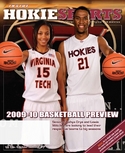Producers Jed Castro (right) and Brian Walls (left), and graphic artist Megan Caligiuri (center) are a big part of that staff, and they recently shed some light on what their job is like.
Believe it or not, we can play a role in the outcome of the game.
Caligiuri: From a technical perspective behind the camera, you don’t realize how critical the angles that we are shooting can be. We are relied upon by the officials when they are reviewing a play. They have to have the right angle to see whether the ball was dropped or whether a player was out of bounds. That is one instance where it is important to have the right shot.
Castro: That’s especially true with basketball if the game isn’t on TV. We still run the game on the videoboard, but the refs might want to see if a player had his or her foot on the 3-point line. We have to find a way not to show the replay to everyone in the Coliseum, but to still be able to show it on the monitor that the refs have.
Shooting the games is a lot of fun …
Walls: One of the most fun parts of the job is getting behind the camera. There is a lot of artsy stuff to it. We’re not necessarily just shooting the play, but maybe the fans if they’re going crazy. Maybe you have the moon in the background of a full stadium shot. Each camera has a different aspect.
Castro: We have five cameras just for HokieVision and not all of them are focused on the field at the same time. We try to have a camera that has the reaction of the coaches. We need to get a shot of the fans to show their mood. And we’ve got communication. Our director is telling us through the headsets what he wants to get shots of. A lot of times, we’re not necessarily seeing the action that’s on the field, so we have to go back ourselves and watch the TV copy. We won 31-7, but how did we score those touchdowns? Sometimes, I don’t really know.
… but there’s a lot more to it than that.
Walls: We probably spend maybe three hours a week behind a camera, but the other 50 or 60 hours are in front of the computer editing or logging or adding graphics.
Caligiuri: I think it keeps things interesting. We don’t work a 9-5 job. We work six days a week during the season, but different hours all the time. We’re not doing the same thing every day, and once basketball starts, we’re working those games at night, so it provides variation that other jobs might not necessarily have.
When the game ends, our work begins.
Castro: The games are fun, but as soon as the game is over, everyone else goes out downtown. We’re like, “That’d be nice,” but we have to stick around. Brian’s cutting the highlights right after the game to go out on the Internet. I’ve got to go shoot the postgame interviews. Megan’s working with Hokie Playback right after the game because that’s got to be edited and go out within two or three hours. It’d be great to get out of here when the final whistle blows, but we’re probably here for three more hours on a good day.
We also provide a lot to outside sources.
Walls: Whether it’s a phone call from somebody at Collegiate Images or somebody from the ACC who wants highlights from our last game, it’s almost an every day thing.
Castro: For example, the volleyball team got off to its best start ever this season, but a lot of TV stations aren’t here shooting that, so they’ll come to us for highlights. And when the networks come in to televise a game, a lot of it is, “Hey, we need a shot of the national championship case,” or, “We need some beauty shots of the campus.” I would say that’s a pretty big part of our job.
It’s not just all football and basketball.
Castro: We’re each responsible for certain sports outside of that, making sure that stuff gets shot and making sure that we keep a log of all the highlights.
Caligiuri: The student interns are the ones who typically shoot the Olympic sports games. We oversee them, making sure that those other sports are getting filmed and that the highlights are good enough to show on the Web site [Hokies All-Access].
We were fans before we got the job.
Castro: All three of us went to Tech. I think it would be difficult to do this job at any other place because we really care about if the Hokies win or lose. We have a vested interest in the success of the teams that we work with. We get familiar with a lot of the players and coaches, so it’s good to see the people you work with be able to succeed.




